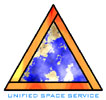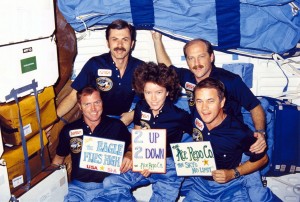ELKHART’S “FAVORITE SON” ASTRONAUT READY FOR NEW CHALLENGE
(originally published in The Elkhart Truth, October 31, 1984)
Two years have passed since Hoosier native and veteran NASA astronaut Joseph P. Allen made his first space flight, but the experience is still vivid in his mind.
“I can’t single out any one thing. It’s the adventure and experience of the whole flight, from beginning to end. We deployed satellites for the first time, and that was pretty spectacular,” Allen said of his STS-5 mission. “I think for me personally, though, just the view of the Earth was something I know I’ll never forget.”
If all goes according to plan, Allen will have an opportunity to refresh that memory beginning Nov. 7. That’s when he and four other astronauts are scheduled to lift off from Kennedy Space Center on an 8-day mission which NASA calls 51-A, and Allen calls “one of the most challenging on the NASA slate.”
Among those watching the launch of Discovery from the space center’s VIP site will be Allen’s wife, the former Bonnie Jo Darling of Elkhart, and her mother Mildred V. Darling, a resident of Greenleaf Manor Apartments.
“I’m getting excited, but a little nervous, too, when you look at how much Joe has to do,” said Mrs. Darling. “But I know it’ll be all right.” After the launch, Mrs. Darling and her daughter plan to fly to the Johnson Space Center in Houston to follow the remainder of the mission.
Allen’s 1982 flight was the payoff for fifteen years of patience. Like the other members of NASA’s “Class of 1967,” Allen was caught in the space agency’s post-Apollo malaise, when the proposed Apollo Applications program was cancelled and the Space Shuttle was still years in the future. Though a number of astronauts left NASA during this period, Allen remained, earning a NASA Scientific Achievement medal and NASA Exceptional Service medal along the way.
 Then in November 1982, Allen was part of the four-man “We Deliver” crew for STS-5, the first operational mission of the orbiter Columbia. A collection of photographs taken by Allen during the flight can be found in the book Answering Space, just published by Stewart, Tabori & Chang.
Then in November 1982, Allen was part of the four-man “We Deliver” crew for STS-5, the first operational mission of the orbiter Columbia. A collection of photographs taken by Allen during the flight can be found in the book Answering Space, just published by Stewart, Tabori & Chang.
“So many things were stranger than I expected,” Allen said after that flight. “The view from 190 miles above Earth was so unbelievable it was difficult to tear myself away from the windows and do my work.”
Among Allen’s responsibilities was supervising the successful launch of a Canadian telecommunications satellite called Anik. By coincidence, Allen’s responsibilities on the upcoming flight include supervising the launch of another Anik satellite.
“They must have liked the good service,” Allen joked.
But Allen will see some differences as well, one of the most welcome of which will be more elbow room on both the flight deck and the middeck. “This one (Discovery) is roomier by a third, because it doesn’t have as much dedicated orbiter testing gear carried inside,” Allen said. “Discovery also doesn’t have any (bulky) ejection seats, which Columbia had in her at the time.”
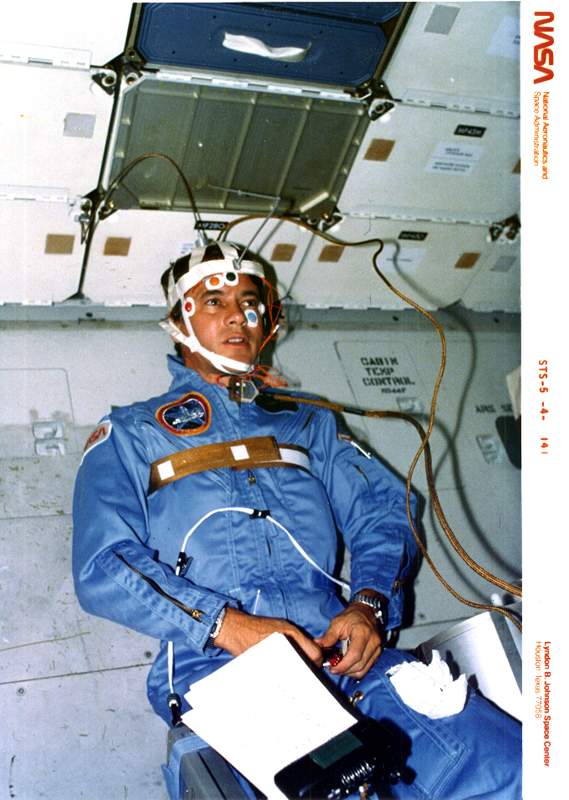 This time around, Allen will also have a better seat for what astronaut Sally Ride has dubbed “the A ticket.” For both liftoff and landing, he will be on the flight deck with its broad windows rather than on the enclosed middeck.
This time around, Allen will also have a better seat for what astronaut Sally Ride has dubbed “the A ticket.” For both liftoff and landing, he will be on the flight deck with its broad windows rather than on the enclosed middeck.
Allen and his fellow mission specialist William Lenoir were the victims of the STS-5 mission’s most frustrating failure. They were to conduct the first operational test of the Shuttle spacesuits by making the first spacewalks of the Shuttle era. But problems with the suits’ ventilation and cooling system forced NASA to cancel the spacewalks.
“It was a disappointment in terms of not getting to do something that would have been an incredible experience,” Allen said at the time.
But the upcoming flight has the potential for wiping away that disappointment, for Allen and his crewmate Dale Gardner are scheduled to don spacesuits and jetpacks in a dramatic attempt to recover two communications satellites stranded last February in useless orbits.
“We work as a team on both,” Allen said. “It’s certainly a two-man task, if not two-and-a-half. On the first recovery, the Palapa, I’ll fly the MMU and Dale will handle a lot of the large tools, then we’ll swap roles on the second.”
Preparation for the rescue attempt has included “an awful lot of time in simulations” and “about a hundred more hours” in the water tank used to practice spacewalk techniques.
“We’ve been working pretty hard on this most of the summer,” Allen said. “No question, we ended up with one of the most interesting and most challenging flights that’s on the NASA slate at the moment.”
HOOSIER ASTRONAUT TO BE SPACE-AGE KNIGHT
(originally published in The Elkhart Truth, November 1, 1984)
On the fifth day of the upcoming Space Shuttle mission, Hoosier astronaut Dr. Joseph P. Allen will venture forth from the cargo bay of the orbiter Discovery looking like a lance-wielding space-age knight.
But Allen’s quest will be to rescue not a maiden, but a helpless 1300-pound, 7-foot diameter communications satellite called Palapa B2. If he is successful, two days later Purdue alumnus Dale Gardner will attempt to duplicate the feat with a satellite called Westar VI. The dual satellite rescue is expected to be the highlight of the upcoming 51-A mission, scheduled to begin November 7.
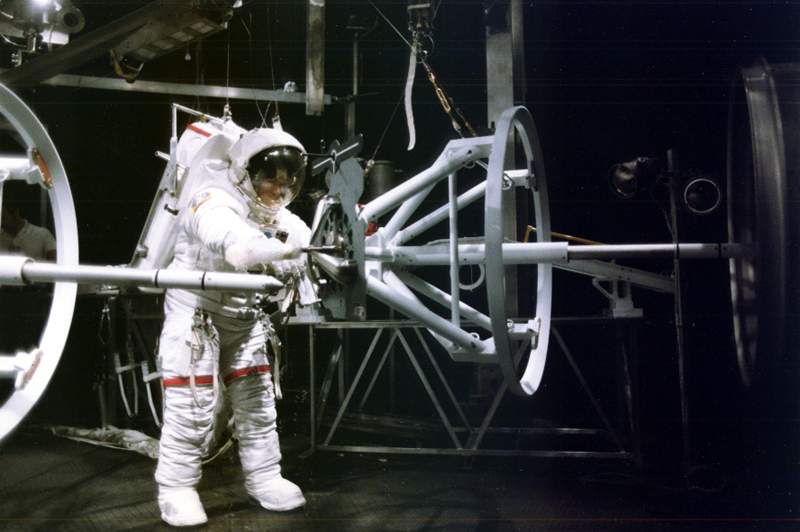 “The way we’ll get them is to attach a long probe called a stinger to the front of the Manned Maneuvering Unit, and then fly over to the satellite like a knight out of the days of chivalry,” explained Allen, who is married to the former Bonnie Jo Darling of Elkhart.
“The way we’ll get them is to attach a long probe called a stinger to the front of the Manned Maneuvering Unit, and then fly over to the satellite like a knight out of the days of chivalry,” explained Allen, who is married to the former Bonnie Jo Darling of Elkhart.
Allen’s mother-in-law, Mildred V. Darling, is still an Elkhart resident. She and her daughter will watch the spacewalk from NASA’s Johnson Space Center in Houston.
Besides Allen and Gardner, the crew includes commander Frederick Hauck, rookie pilot David Walker, and rookie mission specialist Anna Fisher. Also on the mission plan for 51-A is the launch of new communications satellites owned by Telesat Canada and Intelsat.
“Dale and I are each responsible for a satellite going up and we’re going to go out together as a team to get the two satellites coming down,” Allen said. “Anna is the flight engineer and also is the RMS [Canadarm crane] operator.”
Though the crew has remained intact since being named in September, 1983, both the designation and objectives of their mission have changed several times since then. Their flight was originally set for Aug. 1, 1984, but the birthing pains of the new orbiter Discovery this past summer led to a postponement.
Meanwhile, the failure of the rocket motors attached to two Hughes 356 satellites launched from the Shuttle last February left those satellites stranded in low, useless orbits. The failure, traced eventually to defective exhaust nozzles, resulted in the reshuffling of payloads for several upcoming flights.
“There’s good and bad in that,” Allen noted. “It does show that there’s some flexibility, that we don’t have to have things manifested for months and months at a time in order to get them flown. But some of the changes have been made necessary because of problems with the transportation system. Were we infinitely clever, we wouldn’t wind up with a slip of this sort.”
But the combination of circumstances has put Allen and his crewmates in a position to attempt the first return of an ailing satellite from orbit. To assist in the recovery, controllers have been slowing the rotation of the cylindrical satellites and spiraling them down to a more accessible 200-mile high orbit.
Unlike the Solar Maximum Mission satellite which was repaired in orbit in April, however, the Hughes 356 satellites were not designed to be serviced in space.
“There is no easy way to grab ahold,” Allen said, explaining that he and Gardner must fly underneath their respective satellites and thread the lance-like “stinger” into the narrow mouth of a spent rocket motor.
“These things are like coffee cans, quite symmetrical, and it shouldn’t tend to become unstable,” Allen said. “Even if we bump it, we may nudge it away, but we don’t think we’re going to tumble it. We’re kind of counting on that (stability), because it’s not too easy a task to thread a two-inch diameter probe precisely into a three-inch rocket nozzle hole without touching the sides.”
Once that bit of marksmanship is achieved, the tip of the stinger opens up “like an umbrella” and locks in place inside the motor.
“Once we get it stabilized, the orbiter will grab it with the remote manipulator arm,” said Allen.
Working together, Allen and Gardner will then clamp a circular adapter to a structural ring on the bottom of the satellite, which will then be used to anchor it inside the cargo bay.
Because of the complexities of both the custom hardware and the rescue procedure, development was underway even while NASA and the insurance companies were negotiating an agreement.
“We basically went at it as though it were going to happen. We didn’t have the luxury of waiting until people made up their minds,” Allen said. “We were doing parts of the training for the mission before it was a real mission.”
Those agreements were finalized in September, providing for a consortium of insurance underwriters to pay NASA up to $2.75 million for each successful rescue. Indirectly, those agreements also guarantee Allen a chance at the spacewalk he missed out on during a previous flight in 1982.
“I’m looking forward to it,” Allen said. “I’m ready.”
Indiana’s Allen Preparing for Satellite Rescue
(originally published in The South Bend Tribune, November 2, 1984)
HOUSTON — Two years ago, a defective two-inch fan in his $2 million spacesuit cost Indiana astronaut Joseph P. Allen a chance to take part in the first Shuttle-era spacewalk.
“It was a disappointment not getting to do something that would have been an incredible experience,” Allen admitted after his STS-5 flight in November, 1982.
But during the Shuttle mission scheduled to begin Nov. 7, Allen will get a second chance. If all goes according to plan, on Nov. 12 Allen will climb into a spacesuit, strap on a jetpack, and take part in a daring, first-ever rescue of a crippled satellite stranded in a useless orbit.
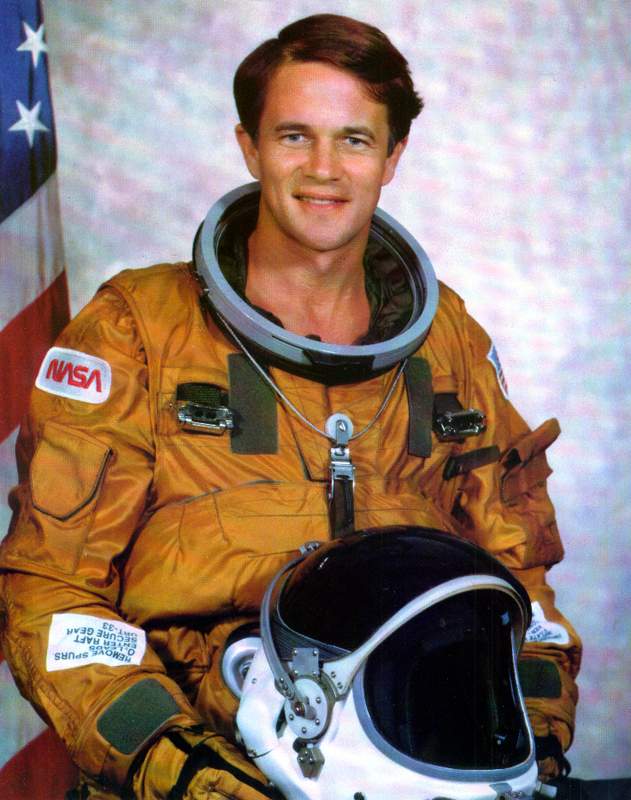 The crew for the second flight of the orbiter Discovery consists of Allen, commander Frederick Hauck, pilot David Walker, and mission specialists Dale Gardner and Anna Fisher.
The crew for the second flight of the orbiter Discovery consists of Allen, commander Frederick Hauck, pilot David Walker, and mission specialists Dale Gardner and Anna Fisher.
“No question, we ended up with one of the most interesting and challenging flights that’s on the NASA slate at the moment,” Allen said in an interview last week.
A native of Crawfordsville and graduate of DePauw University, Allen is married to the former Bonnie Jo Darling of Elkhart. His mother-in-law, Mildred V. Darling, resides in Elkhart.
“I’m getting excited, but a little nervous, too, when you look at how much Joe has to do. But I know it will be all right,” said Mrs. Darling. She plans to watch the launch from Kennedy Space Center with her daughter, and then fly to Houston to follow the remainder of the mission from NASA’s Johnson Space Center.
The first major event will occur on the second day, when Allen will supervise the deployment of a Canadian communications satellite called Anik. “As a matter of fact, I was responsible for Anik on STS-5, and it’s Anik on this flight as well,” Allen said. “So they must have liked the good service.”
A second satellite, LEASAT, will be launched by Purdue alumnus Gardner the next day.
On the fifth day of the flight, Allen and Gardner will attempt to capture the first of two 1300-lb, 7-ft diameter cylindrical satellites left in unusable orbits last February by the separate failures of their rocket motors.
“Dale and I are each responsible for a satellite going up, and we’re going to go out together as a team to get the two satellites coming down,” Allen explained. “It’s certainly a two-man task, if not two-and-a-half.”
The extra “half” will be contributed by flight engineer Anna Fisher, who will operate the 60-foot long Canadian-built robot arm from inside Discovery during both rescue attempts.
A major complication in the recovery is that the Hughes-built satellites, Palapa B2 and Westar VI, are of a type not designed to be serviced or recovered by the Shuttle.
“There is no easy way to grab ahold,” Allen said. “The way we’ll get them is to attach a long probe called a stinger to the front of the Manned Maneuvering Unit, and then fly over to the satellite like a knight out of the days of chivalry. On the first recovery, the Palapa, I’ll fly the MMU and Dale will handle a lot of the large tools.”
Once underneath the slowly-spinning Palapa, Allen will try to guide the lance-like probe into a chink in the satellite’s armor — the narrow mouth of a spent rocket motor.
“Even if we bump it, we may nudge it away, but we don’t think we’re going to tumble it,” Allen said, alluding to the problems another crew faced last April trying to repair the Solar Max satellite. “We’re kind of counting on that (stability), because it’s not too easy a task to thread a 2-inch diameter probe precisely into a 3-inch rocket nozzle hole.”
If Allen is successful, he will next lock the probe in place and stabilize Palapa with the jetpack’s thrusters. After towing Palapa back to where it can be grasped by the orbiter’s robot arm, Allen will stay attached to the satellite while Gardner readies it to be stowed. The final step is for Fisher, using the robot arm, to secure the satellite to a pallet in the cargo bay.
Westar VI is scheduled to receive the same treatment on the seventh day of the mission, with Allen and Gardner swapping roles.
Holding their breath during both 6-hour spacewalks will be not only NASA and the astronauts’ families, but a consortium of insurance underwriters. The insurers have paid NASA $5.5 million in the hope of recovering $70 million worth of satellites.
Rescue options were under development almost from the moment the twin launch failure was understood, but final approval for the attempt did not come until late September.
“We basically went at it as though it were going to happen. We didn’t have the luxury of waiting until people made up their minds,” Allen said. “We were doing parts of the training for the mission before it was a real mission.”
Allen, an avid photographer who recently saw his photos of the STS-5 flight published in the book “Entering Space” (Stewart, Tabori & Chang), is looking forward to seeing one particular sight through his viewfinder again.
“For me personally, just the view of Earth was something I know I’ll never forget,” Allen recalled. “The view from 190 miles above was so unbelievable that it was difficult to tear myself away from the windows and do my work.”
“I can guarantee I’ll have trouble staying away from the windows again,” he added.
Update 2015: The Anik C3 satellite launched from STS-5 was in service from 1982 to 1997, while the Anik D2 satellite launched from STS-51A was in service from 1984 to 1995. Both the Palapa-B and Westar-IV satellites were successfully captured by Allen & Gardner, returned to Earth, and relaunched in 1984 on mission 41B.
